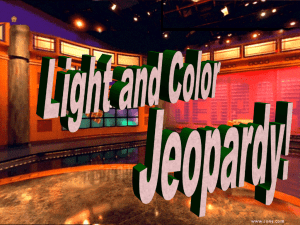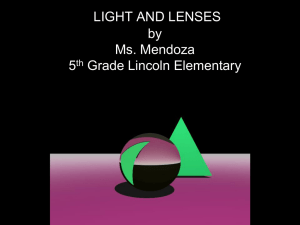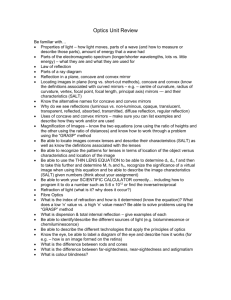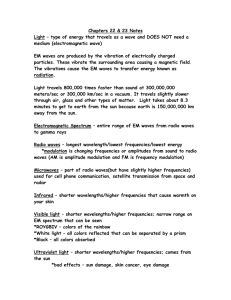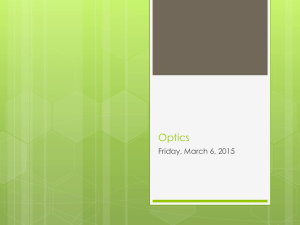Light - TeacherWeb
advertisement
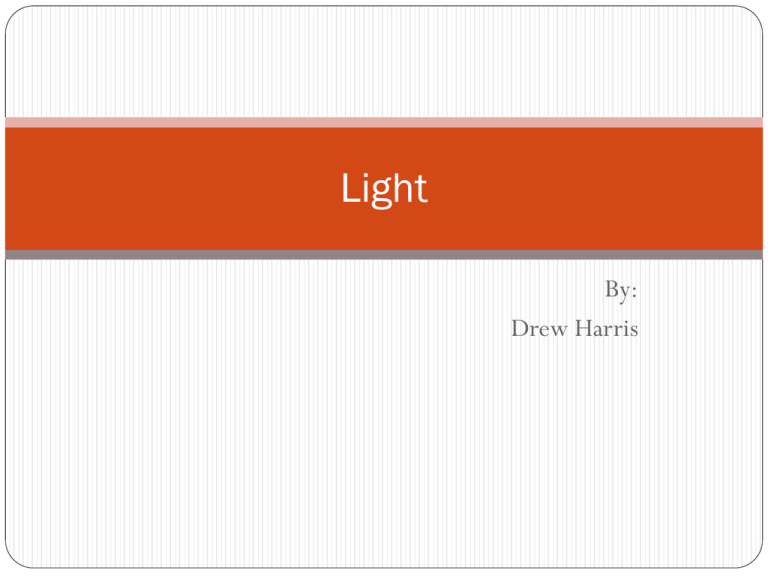
Light By: Drew Harris Light Energy Light Energy Energy is the ability to cause things to change. Light is a type of energy. Without light no one can see anything. Light gives things color. Light shines on plants and makes them grow. Some doctors use light energy to perform operations with lasers. Light energy can make cars move. Satellites turn light into electricity in space. Shadows move and change shape because of the way light travels. Light travels in straight lines. When you put light in front of a light, a shadow appears. That is where light can’t reach directly. When you stand outside, you block lines of sunlight. When the sun is low in the sky, in the morning and afternoon, your shadow is long. Later in the day, your shadow becomes shorter because as the sun moves you block a different angle. Long ago people found out how to tell time by using shadows. The device used was a sundial. Early in the morning the sun is rising in the east. Later in the day, the sun is in the west. The bouncing of light off an object is called reflection. If light bounces off a smooth surface it gives you an image you can see. You can’t see your reflection if you are looking at a bumpy surface. Some surfaces light doesn’t bounce off of. That’s why glass is clear. Whenever light hits a surface at an angle, it bends. This is called refraction. When light hits a wall, it is absorbed by the wall. This is called absorption. When light hits a wall it is absorbed by the wall. This is called absorption. There are three ways an object can interact with light. Scientists have a name for each of them. Most objects are opaque. You cannot see through them. You can see through a translucent object, but the image is blurry. Transparent objects can be completely seen through. Windows are transparent. Sunlight is made up of many different colors. White light is the light we see every day. It is all the sun’s colors. Different colors of light travel at different speeds. This is how a prism bends light. The visible spectrum is made up of all the colors in the rainbow. Sometimes you can see a rainbow after it rains. That is because raindrops act like prisms. Therefore, you can only see it when the sun is behind you. There are many colors in a rainbow, but many people see seven colors. They are red, orange, yellow, green, blue, indigo, and violet. They ALWAYS appear in this order. ROY G BIV is a good way to remember them. R O e r d a n g e Y e l l o w G r e e n B I l n u d e i g o V i o l e t If you shine two colors at one spot, it makes a different color. White light hits every corner you see. Most objects absorb most of the light, but not all. The color that you see is the part that is not absorbed. You can control absorption and reflection by mixing paint. When you mix yellow and blue, instead of blue or yellow, green is reflected. Example: A red and blue striped shirt ROYGBIV Red and blue are reflected Orange, yellow, green, indigo and violet are absorbed Light Vocabulary reflection – the bouncing of light off an object. refraction – the bending of the path of light when it moves from one kind of matter to another. absorption – the stopping of light when it hits a wall or other opaque object. opaque – reflecting or absorbing all light; no image can be seen. translucent – allowing some light to pass through; blurry image can be seen. transparent – allows most light to pass through; clear image can be seen. prism – a solid object that bends light; not a lens. Visible spectrum – the range of light energy that people can see. A lens is a piece of material in which light is able to pass through. Convex lenses are thicker in the middle. Concave lenses are thinner in the middle. Nearsighted is difficulty seeing objects far away. Farsighted is difficulty seeing objects up close. Convex Farsighted Concave Nearsighted Lenses A lens is a piece of material which light is able to pass through. It is used to refract light. Convex – A lens which is thicker in the middle than on the ends. Concave – A lens which thinner in the middle than on the ends. A concave lens looks like the opening to a cave. Therefore, you can remember that it curves in or something that is caving in. Convex lense – Example; magnifier, telescope, glasses, microscope. Refracts parallel light rays so they come together at a single point called convergence. Point is known as focal point. Concave lense – Example: glasses. Refracts the rays so they come apart called divergence. Always forms a virtual image. Nearsighted – difficulty seeing objects far away. Wear glasses with diverging lenses (concave lenses) Farsighted – difficulty seeing objects up close. Wear glasses with converging lenses (convex lenses) Light Review MISCONCEPTIONS PROPER CONCEPTIONS Light Light Light and sound are both forms of energy. Students often associate light only with a Light rays normally travel in straight lines and they can source and they tend to consider only the reflect (bounce) off some objects, refract (bend) instantaneous effects of light. through some, and be absorbed by others. Light sources are often considered only in Some objects allow all the light that hits them to travel through them (transparent); some allow some of the respect to the objects or areas that they light to travel through (translucent), while others illuminate. prevent any light from traveling through them (opaque). There is frequently no recognition that light must move - between the source, the Lenses are used in tools such as microscopes, telescope, binoculars, and cameras. They bend light in useful ways. object, and the observer’s eye. Convex lenses cause light to converge after light passes As students experiment with mirrors, lenses, through them while concave lenses cause light to diverge after light passes through them. and prisms, their understandings of light Prisms can separate white light into the different colors can gain depth. that make it up because each color of light bends differently when it passes through a prism.


